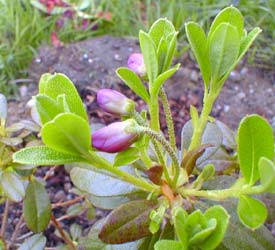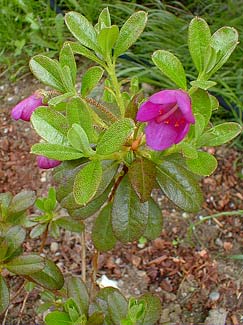
"Cremastum Group" Rhododendron campylogynum
"Her face is rounder than the moon,
And ruddier than the gown
Of orchids in the pasture
Or rhododenron worn."
-Emily Dickenson,
1830-1886
1830-1886
We planted a pair of evergreen dwarf rhododendrons in afternoon sun near the foot of our wonderful Western Azalea/Flame Azalea hybrid.
These two dwarfs are Rhododendron tolmachevii of the scented leaves, & R. campylogynum var. cremastum (aka "Cremastum Group"), which is one of the reddest-flowering of the lepidotes, setting it greatly apart from the usual lepidotes that are generally purple or violet flowering.
The three variant forms, R. c. var. myrtilloides, R. c. var.charopoeum & R. c. var. cremastum, were formerly regarded as distinct species. They vary in size from those which are never more than two or three inches tall even into ripe old age, to shrubs that reach four feet in ten years. So even the largest are pretty small.
 Ours of the "Cremastum Group" is rather upright & broad. Its ten year height could be two or three feet; ours was only about fifteen inches tall on 2003 when these photos were taken. To see it a year later, check the R. campylogynum page of the Rhododendron Blossoms Gallery).
Ours of the "Cremastum Group" is rather upright & broad. Its ten year height could be two or three feet; ours was only about fifteen inches tall on 2003 when these photos were taken. To see it a year later, check the R. campylogynum page of the Rhododendron Blossoms Gallery). The photo at the top of this page was taken on Cinco de Mayo, showing the Cremastum's small but rather fat & very brightly colored buds, nodding twixt spring's newest leaves.
As the flowers open, they bow on longish stalks mostly in pairs or trios, each bloom only about three-fourths inch wide. The second mid-May photo, at right, shows the same branch, with the buds having become fully opened bells, distinctly unlike other rhododendron blossoms.
The widespread species is native of Yunnan, Southeast Tibet, North India, & Upper Burma. It is not nearly as cold-hardy as its fellow Chinese alpine dwarf rhodies, & does not thrive below Zone 7 or minus five degrees F. Extended winter temperatures at ten degrees are enough to damage it. For our Zone 8, it is perfect, & very hardy.
It prefers a full sun position, but tolerates a little shade. In appearance it is compact & upright with the stance of a bonsai tree, looking very mature even at a tiny size.
This shrub has considerable all-season interest. The leaves turn a golden yellow in November, very slowly darkening through December. By January the leaves turn a chocolaty mahagony. Leaf portraits can be seen along the Rhododendron campylogynum Page of the Autumn & Winter Rhodies Garden Walk.
See also the named clone
R. campylogynum var. cremastum'Bodnant Red.'
R. campylogynum var. cremastum'Bodnant Red.'